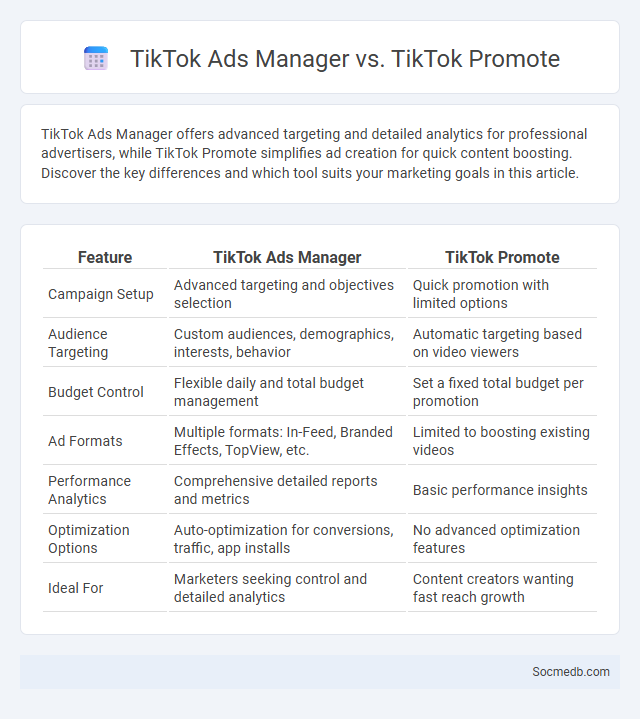
Photo illustration: TikTok Ads Manager vs TikTok Promote
TikTok Ads Manager offers advanced targeting and detailed analytics for professional advertisers, while TikTok Promote simplifies ad creation for quick content boosting. Discover the key differences and which tool suits your marketing goals in this article.
Table of Comparison
| Feature | TikTok Ads Manager | TikTok Promote |
|---|---|---|
| Campaign Setup | Advanced targeting and objectives selection | Quick promotion with limited options |
| Audience Targeting | Custom audiences, demographics, interests, behavior | Automatic targeting based on video viewers |
| Budget Control | Flexible daily and total budget management | Set a fixed total budget per promotion |
| Ad Formats | Multiple formats: In-Feed, Branded Effects, TopView, etc. | Limited to boosting existing videos |
| Performance Analytics | Comprehensive detailed reports and metrics | Basic performance insights |
| Optimization Options | Auto-optimization for conversions, traffic, app installs | No advanced optimization features |
| Ideal For | Marketers seeking control and detailed analytics | Content creators wanting fast reach growth |
Overview: TikTok Ads Manager vs TikTok Promote
TikTok Ads Manager offers comprehensive campaign customization with advanced targeting options, detailed analytics, and multiple ad formats tailored for marketing professionals and businesses seeking extensive control over their ad spend and audience reach. TikTok Promote simplifies advertising by enabling users to boost existing organic videos directly from the TikTok app, ideal for creators and small businesses aiming for quick exposure without managing detailed campaign settings. Both tools integrate with TikTok's algorithm to maximize engagement but cater to different levels of advertising experience and marketing goals.
Key Features Comparison
Social media platforms vary significantly in features, with Facebook offering robust community groups and marketplace functionality, Twitter excelling in real-time news updates and hashtag trends, and Instagram prioritizing visual content through Stories and Reels. LinkedIn stands out with professional networking and job search tools, while TikTok emphasizes short-form video algorithms for personalized content delivery. Understanding these key feature differences aids in selecting the appropriate platform to meet marketing, networking, or content-sharing objectives effectively.
Campaign Objectives and Ad Formats
Campaign objectives on social media include brand awareness, lead generation, website traffic, and conversions, each designed to align with specific marketing goals. Ad formats such as photo ads, video ads, carousel ads, and stories ads provide versatile ways to capture your audience's attention and drive engagement. Selecting the right objective and ad format optimizes ad performance, ensuring your social media campaigns deliver measurable results.
Audience Targeting Capabilities
Social media platforms offer advanced audience targeting capabilities that allow you to reach specific demographics based on interests, behaviors, location, and more. These precise targeting options improve the efficiency of your marketing campaigns by delivering tailored content to the most relevant users. Leveraging tools like Facebook Ads Manager or LinkedIn Campaign Manager enhances your ability to engage potential customers with personalized messaging.
Customization and Advanced Targeting Options
Social media platforms offer extensive customization features that allow you to tailor content, ads, and profiles to match specific brand identities and audience preferences. Advanced targeting options enable precise segmentation based on demographics, interests, behaviors, and location, significantly increasing engagement and conversion rates. Leveraging these tools maximizes your marketing efficiency by delivering relevant messages directly to the most valuable users.
Budget and Cost Considerations
Social media advertising budgets vary widely depending on campaign objectives, platform choice, and target audience size, with average costs ranging from $0.50 to $3.00 per click on platforms like Facebook and Instagram. Utilizing precise audience targeting and A/B testing can optimize spending efficiency, maximizing return on investment (ROI) within set budgets. Small businesses often allocate 5-15% of their total marketing budget to social media, balancing cost with effective reach and engagement metrics.
Analytics and Performance Tracking
Social media analytics involve collecting and examining data from platforms like Facebook, Instagram, and Twitter to measure engagement, reach, and conversion rates. Performance tracking tools such as Google Analytics, Hootsuite Insights, and Sprout Social provide real-time metrics that help optimize content strategy and improve ROI. Leveraging these insights enables businesses to tailor campaigns, boost user interaction, and maximize brand visibility across diverse digital channels.
Ease of Use and Accessibility
Social media platforms are designed with intuitive interfaces that prioritize ease of use, enabling users of all technical skill levels to navigate and engage effortlessly. Features such as customizable layouts, voice commands, and simplified content sharing enhance accessibility for individuals with disabilities or limited digital literacy. Cross-platform compatibility ensures that social media remains accessible on various devices, from smartphones to desktops, fostering inclusive communication worldwide.
Best Use Cases for Businesses
Social media platforms offer businesses unparalleled opportunities for brand awareness, customer engagement, and targeted advertising. Utilizing tools like Facebook Ads, Instagram Stories, and LinkedIn content marketing enables precise audience targeting and real-time interaction. Influencer collaborations and user-generated content campaigns significantly boost credibility and organic reach.
Choosing the Right Tool for Your Marketing Goals
Selecting the right social media platform is crucial for achieving your marketing goals efficiently. Analyze audience demographics, engagement rates, and content formats on platforms like Instagram, LinkedIn, or TikTok to align with your target market. You can maximize ROI by tailoring your content strategy to the platform that best supports your brand's objectives and messaging style.
 socmedb.com
socmedb.com